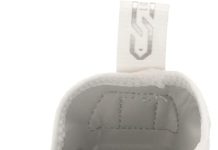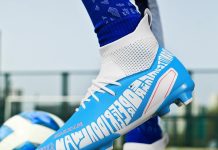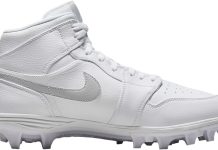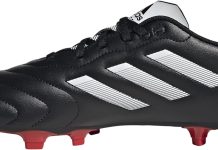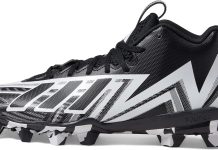Maintaining your cleats is critical to ensuring a long and prosperous life on the field. From cleaning to storage, you can take several simple steps to help your cleats withstand the wear and tear of intense gameplay.
In this article, we’ll explore some invaluable tips and tricks to keep your cleats in top shape, allowing you to focus on what you do best – dominating the game.
Cleaning and Drying Cleats
Review contents
Removing Dirt and Debris
Cleaning and maintaining your cleats is essential to ensure their longevity and performance. The first step in cleaning your cleats is removing any dirt and debris that may have accumulated. This can be done by simply tapping the cleats together or using a soft brush to brush away the dirt gently. It is essential to be gentle during this process to avoid damaging any delicate parts of the cleats.
Using a Soft Brush or Cloth
Once you have removed the dirt and debris from your cleats, the next step is to use a soft brush or cloth to clean them further. Gently brush the surface of the cleats, paying attention to any areas with stubborn dirt or stains. You can also use a damp cloth to wipe down the cleats, freeing them from any remaining dirt or residue. Avoid using harsh cleaning agents or abrasive materials, as these can damage the materials and colors of the cleats.
Drying Cleats Properly
After cleaning your cleats, it is essential to dry them thoroughly before storing or using them again. Excess moisture can lead to odor, mold, and deterioration of the materials. First, dry your cleats and remove any excess moisture with a towel or cloth. Then, allow the cleats to air dry in a well-ventilated area, away from direct sunlight and heat sources. Avoid using a hairdryer or any other artificial heat source, as this can cause damage to the materials. It is essential to ensure the cleats are completely dry before storing or using them to prevent moisture-related issues.
Storing Cleats
Removing Insoles and Laces
To properly store your cleats, removing the insoles and laces is advisable. This helps to ensure that all parts of the cleats can thoroughly dry and prevents any unwanted odors or moisture buildup. Insoles can be gently pulled out of the cleats and set aside. If the laces are removable, it is recommended to untie and remove them. If the laces are not removable, loosen them to allow proper airflow within the cleats.
Using Shoe Trees or Stuffing Newspaper
Once the insoles and laces have been removed, properly shaping and supporting the cleats during storage is essential. One option is to use shoe trees specifically designed for cleats. These shoe trees help maintain the shape of the cleats and allow air circulation. If shoe trees are unavailable, an alternative is to stuff the cleats with newspaper to help them retain their shape and absorb any excess moisture. Make sure to change the newspaper regularly to prevent mold or odor issues.
Avoiding Extreme Temperatures
When storing cleats, keeping them in an environment with stable and moderate temperatures is crucial. Extreme heat or cold can have detrimental effects on the materials and structure of the cleats. Avoid storing them in hot car trunks or a freezing garage. Instead, find a cool and dry place to store your cleats, such as a closet or a designated storage box. This will help to maintain their quality and prolong their lifespan.
Protecting Cleats During Use
Avoiding Excessive Wear on Hard Surfaces
To protect your cleats during use, it is essential to be mindful of the surfaces on which you are playing. Excessive wear on hard surfaces, such as concrete or pavement, can cause quick deterioration of the cleats’ studs or spikes. Whenever possible, try to play on grass, turf, or other designated playing surfaces that are softer and more forgiving to the cleats. If playing on hard surfaces is unavoidable, consider using cleat covers or alternate footwear to minimize the wear and tear on your cleats.
Avoiding Contact with Sharp Objects
Another critical aspect of protecting your cleats is to avoid contact with sharp objects. Cleats can easily get caught or damaged when coming into contact with rocks, metal edges, or other sharp surfaces. Be cautious of your surroundings while wearing cleats, and take extra care to avoid stepping on or kicking any sharp objects. Routinely check your cleats for any signs of damage or wear caused by sharp objects, and address any issues promptly to prevent further damage.
Avoiding Water Damage
Water damage is another significant concern when it comes to maintaining the longevity of your cleats. Excessive exposure to water can cause the materials to weaken, deteriorate, or develop mold and unpleasant odors. While it may be impossible to completelyr contact completely during sports activities altogether, taking certain precautions can help minimize the potential damage. Treat your cleats with a waterproofing spray or apply a thin layer of beeswax to create a protective barrier against moisture. Also, thoroughly dry your cleats after each use to prevent any lingering moisture-related issues.
Repairing Cleats
Fixing Loose Soles
Over time, the soles of your cleats may begin to detach or become loose. This can significantly affect their performance and put them at risk of injury. If you notice any signs of loose soles, it is essential to address the issue promptly. Depending on the severity of the damage, you may be able to fix it yourself by using a solid adhesive designed explicitly for shoe repairs. Apply the adhesive according to the manufacturer’s instructions and firmly press the sole back into place. Allow sufficient drying time before using the cleats again.
Repairing Torn Uppers
The uppers of your cleats, the top part of the shoe covering the foot, can also experience wear and tear over time. If you notice any rips, tears, or damage to the uppers, it is essential to repair them to maintain the integrity of the cleats. Depending on the extent of the damage, you may be able to fix minor tears by using a shoe repair adhesive or specialized patches for shoes. For more severe damage, you should take your cleats to a professional shoe repair shop for proper repair and reinforcement.
Replacing Worn-out Studs or Spikes
The studs or spikes on your cleats provide traction and stability while playing sports. Over time, these studs or spikes can wear down or become damaged, compromising their effectiveness. If you notice significant wear or damage to the studs or spikes, it may be time to replace them. Most cleats allow for the replacement of studs or spikes through screw-in or snap-on mechanisms. Consult the manufacturer’s instructions or seek professional guidance to ensure you select the appropriate replacements and follow the correct installation procedures.
Replacing Cleats
Knowing When to Replace Cleats
Despite proper maintenance and repairs, there comes a point when it is necessary to replace your cleats. Signs that indicate it may be time for a new pair include significant wear on the soles or studs, visible and irreparable damage to the uppers, or loss of performance due to diminished grip or stability. It is essential to recognize these signs and invest in a new pair of cleats when necessary to avoid potential injuries and maintain optimal performance.
Choosing the Right Cleats for Your Sport
When it comes to replacing your cleats, choosing the right pair for your sport is crucial. Different sports have different requirements and playing surfaces, which can significantly affect the functionality and durability of the cleats. Consider factors such as the type of playing surface, the level of ankle support needed, and the specific traction requirements for your sport. Consult with knowledgeable professionals or do thorough research to ensure you select the appropriate cleats that will enhance your performance and provide the necessary support and protection.
Considering the Playing Surface
Finally, when replacing your cleats, it is essential to consider the playing surface on which you will be using them. Different playing surfaces require different types of cleats to ensure optimal performance and minimize the risk of injury. For example, firm ground cleats are designed for natural grass surfaces, while turf cleats are more suitable for synthetic turf. There are also specialized cleats for indoor sports or muddy conditions. Selecting the correct type of cleats for the specific playing surface will prolong their lifespan, enhance your performance, and keep you safe during sporting activities.
By following these maintenance tips and adequately caring for your cleats, you can ensure they will last longer and continue to perform at their best. Remember to clean and dry your cleats after each use, store them in a suitable environment, protect them during activities, repair any damages promptly, and replace them when necessary. Taking these steps will help extend the life of your cleats and ensure you can enjoy your favorite sports with maximum comfort, performance, and safety.







